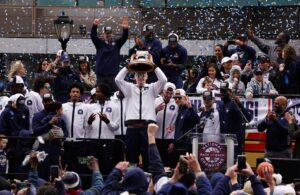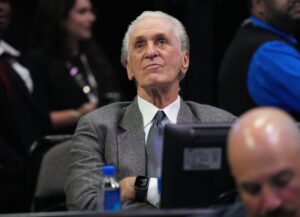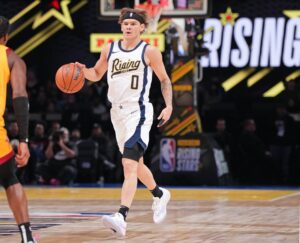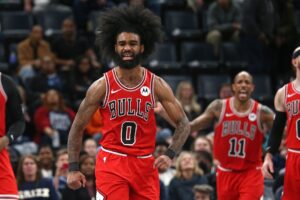During the 2016-17 NBA season, headlines will be dominated by Kevin Durant and the Golden State Warriors on a daily basis. However, having a super-team doesn’t guarantee a championship; just look at the 2012-13 Los Angeles Lakers. Everything can change and anything can happen in the NBA. A team can implode, the injury bug could strike, or a team simply might not play to its potential. In this Last Word On Pro Basketball series, we’ll break down which two key factors will determine the fate of each NBA team in the upcoming season.
In this edition, we’ll take a look at the Los Angeles Clippers.
Two Key Factors to a Successful Los Angeles Clippers Season
The Los Angeles Clippers have an inglorious playoff history, making only twelve appearances in 46 years. Unarguably, we are witnessing the franchise’s most successful era to date. L.A. has earned playoff berths in each of the last five seasons. Yet the Clippers have never made it past the second round, plagued by injuries and epic team meltdowns. Their talented core of Chris Paul, Blake Griffin, DeAndre Jordan, and J.J. Redick is returning for the 2016-17 season. They’ve also got solid role players including Jamal Crawford and Marreese Speights coming off the bench. All of that should add up to a great season for the Clippers. In fact, they may prove to be the only team in the Western Conference with enough star power to challenge the Golden State Warriors for the conference title.
First Key: The Bench
The Clippers’ greatest weakness over the last five years has been their lack of depth. This off-season, L.A. sought to address that issue by re-signing key supporting players, as well as rounding out its bench with some experienced veterans on one- or two-year minimum deals. Below, we take a closer look at some of these players.
Marreese Speights
Forward-center Marreese Speights was a great off-season acquisition for the Clippers. So far, in the preseason, he has proven to be a good fit in their bench rotation. Speights, who spent the last three seasons with the Warriors, has scored in double-digits in three out of four exhibition contests. He’s also been strong on the boards, with rebound totals of five, six, and eight. His ability to consistently hit mid-range jump shots and three-pointers will help open up the floor for the Clippers offensively, expanding their scoring options. Speights lacks the defensive spark of Cole Aldrich, who left the Clippers as a free agent in the off-season. Nonetheless, Speights is a competent back-up big man. He had some nice moments for the Warriors last season, averaging 7.1 points and 3.3 boards in just 11.6 minutes per game, and should provide similar contributions in Los Angeles.
Brandon Bass
The Clippers get some extra depth in the power forward spot with former Los Angeles Lakers forward Brandon Bass. Although Bass averaged just over seven points and four rebounds per game with the Lakers last year, his poorest performance since the 2009-10 season, he is capable of offering solid production off the bench. Bass demonstrated his scoring ability this past week with a 16-point (7-13 FG, 2-2 FT), six-rebound performance against the Portland Trail Blazers. Along with Speights, Bass considerably improves the Clippers reserve frontcourt heading into the regular season.
Alan Anderson
Injuries may prove to be an issue with guard/forward Alan Anderson, who signed with the Clippers in early August. Anderson was sidelined by ankle, groin, and hamstring injuries for all but 13 games with the Washington Wizards last season. The 6’6″ Anderson is best known for his defensive prowess on the wing. However, he’s also a decent shooter, making 34.5 percent of his three-pointers in his career. With the Wizards, Anderson averaged 5.0 points, 2.1 rebounds, and 1.1 assists per game. The seven-year veteran’s career statistics are slightly higher, at 7.8 points, 2.3 rebounds, and 1.2 assists per game. Anderson’s ability to produce on offense could prove valuable to the Clippers. When healthy, he may be able to stretch the floor and pull defenders away from Paul and Redick.
Anderson has been battling with Luc Mbah a Moute and Wesley Johnson for the starting small forward role during this exhibition season. However, it’s more than likely that Anderson will come off the bench. Earlier this month, he was one of very few bright spots in the Clippers’ 45-point loss to the Warriors. Anderson contributed ten points in just 11 minutes on the floor. He shot 2-for-3 from the field and 5-for-5 from the free throw line. If he can stay healthy, Anderson should have success in the Clippers’ lineup.
Returning Bench Players
The Clippers re-signed three-time Sixth Man of the Year award winner Jamal Crawford, reserve guard Austin Rivers, and the aforementioned Wesley Johnson.
Crawford’s role with the Clippers is crucial, as he gives the team an offensive spark off the bench. While Crawford’s offensive abilities are undeniable, he has a tendency to be streaky, and his defense is often uninspiring. Rivers, whose abilities are frequently overshadowed by claims of nepotism, has fared decently on offense. Rivers’ real strengths, though, are on the defensive end. Both Crawford and Rivers lack the ability to incorporate others into the offense well. Their heavy reliance on isolation play stalls the Clippers offense by reducing flow and ball movement.
Johnson, the fourth pick in the 2010 NBA Draft, has never played up to expectations. Although he can hit open jumpshots and be a disruptive force on defense, Johnson’s overall contributions to the Clippers have been underwhelming. Johnson averaged just seven points and three rebounds in 21 minutes per game last season. Still, no one really expects him to improve this season. The Clippers have long struggled to secure competency and depth at the small forward position. Time will tell if this season’s rotation of Johnson, defensive stopper Mbah A Moute, and Anderson provides the Clippers with capable enough options to work towards their championship aspirations.
Second Key: Stagger Griffin and Paul
Doc Rivers‘ substitution rotations have mostly consisted of playing and sitting Griffin and Paul together. Staggering the on-court time of two star players can work, as we have seen with teams like the San Antonio Spurs and the Oklahoma City Thunder. In order to maximize the Clippers’ offensive efficiency and maintain the health of their stars through playoffs, Rivers should consider making such an adjustment to his player rotations to better capitalize on existing squad talent.
Paul Doesn’t Need Griffin on the Floor
Chris Paul is an elite playmaker. He led the league in assists in two of the last three seasons, averaging over 10 assists per game. He actually ranks 11th among the NBA’s all-time assists leaders. He also ranks second of all time for assist percentage, with a career average of 47.15 percent.
In Griffin’s absence last season, Paul assisted on a league-leading 52.7 percent of his team’s baskets while on the floor. He also confirmed his status as a scoring threat. His points per game average during Griffin’s absence was the highest since he joined the Clippers. In January and February 2016, he averaged over 21 points per game.
In fact, Paul let the Clippers to 31 wins in 45 games without Griffin last season. That illustrates just how good the team can be without both stars on the floor. That is not to say that Paul and Griffin aren’t great together, as they obviously are. It’s just that in order to survive the season and reach the playoffs at peak performance, they may have to spend some time apart.
Griffin as a Second Unit Anchor
One of the benefits of staggering Paul and Griffin is that it would allow Griffin to serve as an anchor for the Clippers’ historically under-achieving second unit. Griffin is easily one of the most skilled big men in the NBA, especially as a facilitator. He averaged 4.9 assists per game last season, and 5.3 in 2014-15. He achieved a career-high assist percentage of 27.2 last season and 26.2 in 2014-15.
Griffin was an absolute force in the 2015 playoffs, when Paul was forced to miss a couple of games due to a hamstring injury. Griffin averaged 30 points, 14.5 rebounds, and 8.5 assists per game in the first two contests of the Houston series that Paul missed. For the entire postseason, he averaged 6.1 assists per game.
Pairing Griffin’s playmaking ability with the second unit makes sense. It will help stabilize the offense and avoid dips in production during game rotations. When the offense is run through Crawford or the younger Rivers, it frequently stagnates, devolving into a series of isolation plays and rendering other players useless on the court. Griffin is an excellent passer with superb court vision, has the quickness and dribbling ability to lead a fast break, and exhibits sound decision-making. He presents a constant offensive threat with his ability to drive, dunk, and nail mid-range jumpers, but can just as easily facilitate for Crawford, Johnson, and Rivers in catch-and-shoot situations. Griffin’s interior passing ability would also allow better utilize the newly-acquired veteran big men, Bass and Speights. With all of these positives, Doc Rivers has should test sets allowing the Clippers to run their second unit’s offense through Griffin.
Main photo:






